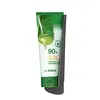What's inside
What's inside
 Key Ingredients
Key Ingredients

 Benefits
Benefits

 Concerns
Concerns

No concerns
 Ingredients Side-by-side
Ingredients Side-by-side

Aloe Barbadensis Leaf Extract 90%
EmollientDimethicone
EmollientGlycerin
HumectantCaprylic/Capric Triglyceride
MaskingCetyl Ethylhexanoate
EmollientDiglycerin
HumectantC14-22 Alcohols
Emulsion StabilisingCarbomer
Emulsion StabilisingPolysorbate 60
EmulsifyingPhenoxyethanol
PreservativeChlorphenesin
AntimicrobialC12-20 Alkyl Glucoside
EmulsifyingPotassium Hydroxide
BufferingEthylhexylglycerin
Skin ConditioningDisodium EDTA
Glucose
HumectantPanthenol
Skin ConditioningBambusa Vulgaris Water
Skin ConditioningBetula Platyphylla Japonica Juice
Skin ConditioningButylene Glycol
HumectantCamellia Sinensis Leaf Extract
AntimicrobialAngelica Keiskei Extract
AntioxidantHouttuynia Cordata Extract
Skin ConditioningNelumbo Nucifera Extract
Skin ConditioningOryza Sativa Extract
AbsorbentArtemisia Annua Extract
MaskingSaccharomyces Ferment
Skin ConditioningParfum
MaskingAloe Barbadensis Leaf Extract 90%, Dimethicone, Glycerin, Caprylic/Capric Triglyceride, Cetyl Ethylhexanoate, Diglycerin, C14-22 Alcohols, Carbomer, Polysorbate 60, Phenoxyethanol, Chlorphenesin, C12-20 Alkyl Glucoside, Potassium Hydroxide, Ethylhexylglycerin, Disodium EDTA, Glucose, Panthenol, Bambusa Vulgaris Water, Betula Platyphylla Japonica Juice, Butylene Glycol, Camellia Sinensis Leaf Extract, Angelica Keiskei Extract, Houttuynia Cordata Extract, Nelumbo Nucifera Extract, Oryza Sativa Extract, Artemisia Annua Extract, Saccharomyces Ferment, Parfum
Water
Skin ConditioningButylene Glycol
HumectantAzelaic Acid
BufferingCaprylic/Capric Triglyceride
MaskingBehenyl Alcohol
EmollientDimethicone
EmollientGlyceryl Stearate
EmollientSorbitan Stearate
EmulsifyingPolysorbate 60
EmulsifyingPolyacrylate Crosspolymer-6
Emulsion StabilisingPhenoxyethanol
PreservativePotassium Hydroxide
BufferingPotassium Cetyl Phosphate
EmulsifyingBisabolol
MaskingEthylhexylglycerin
Skin ConditioningTocopheryl Acetate
AntioxidantGlycerin
HumectantO-Cymen-5-Ol
AntimicrobialDisodium EDTA
Beta-Glucan
Skin Conditioning1,2-Hexanediol
Skin ConditioningHydroxyacetophenone
AntioxidantWater, Butylene Glycol, Azelaic Acid, Caprylic/Capric Triglyceride, Behenyl Alcohol, Dimethicone, Glyceryl Stearate, Sorbitan Stearate, Polysorbate 60, Polyacrylate Crosspolymer-6, Phenoxyethanol, Potassium Hydroxide, Potassium Cetyl Phosphate, Bisabolol, Ethylhexylglycerin, Tocopheryl Acetate, Glycerin, O-Cymen-5-Ol, Disodium EDTA, Beta-Glucan, 1,2-Hexanediol, Hydroxyacetophenone
 Reviews
Reviews

Ingredients Explained
These ingredients are found in both products.
Ingredients higher up in an ingredient list are typically present in a larger amount.
Butylene Glycol (or BG) is used within cosmetic products for a few different reasons:
Overall, Butylene Glycol is a safe and well-rounded ingredient that works well with other ingredients.
Though this ingredient works well with most skin types, some people with sensitive skin may experience a reaction such as allergic rashes, closed comedones, or itchiness.
Learn more about Butylene GlycolThis ingredient is an emollient, solvent, and texture enhancer. It is considered a skin-softener by helping the skin prevent moisture loss.
It helps thicken a product's formula and makes it easier to spread by dissolving clumping compounds.
Caprylic Triglyceride is made by combining glycerin with coconut oil, forming a clear liquid.
While there is an assumption Caprylic Triglyceride can clog pores due to it being derived from coconut oil, there is no research supporting this.
Learn more about Caprylic/Capric TriglycerideDimethicone is a type of synthetic silicone created from natural materials such as quartz.
What it does:
Dimethicone comes in different viscosities:
Depending on the viscosity, dimethicone has different properties.
Ingredients lists don't always show which type is used, so we recommend reaching out to the brand if you have questions about the viscosity.
This ingredient is unlikely to cause irritation because it does not get absorbed into skin. However, people with silicone allergies should be careful about using this ingredient.
Note: Dimethicone may contribute to pilling. This is because it is not oil or water soluble, so pilling may occur when layered with products. When mixed with heavy oils in a formula, the outcome is also quite greasy.
Learn more about DimethiconeDisodium EDTA plays a role in making products more stable by aiding other preservatives.
It is a chelating agent, meaning it neutralizes metal ions that may be found in a product.
Disodium EDTA is a salt of edetic acid and is found to be safe in cosmetic ingredients.
Learn more about Disodium EDTAEthylhexylglycerin (we can't pronounce this either) is commonly used as a preservative and skin softener. It is derived from glyceryl.
You might see Ethylhexylglycerin often paired with other preservatives such as phenoxyethanol. Ethylhexylglycerin has been found to increase the effectiveness of these other preservatives.
Glycerin is already naturally found in your skin. It helps moisturize and protect your skin.
A study from 2016 found glycerin to be more effective as a humectant than AHAs and hyaluronic acid.
As a humectant, it helps the skin stay hydrated by pulling moisture to your skin. The low molecular weight of glycerin allows it to pull moisture into the deeper layers of your skin.
Hydrated skin improves your skin barrier; Your skin barrier helps protect against irritants and bacteria.
Glycerin has also been found to have antimicrobial and antiviral properties. Due to these properties, glycerin is often used in wound and burn treatments.
In cosmetics, glycerin is usually derived from plants such as soybean or palm. However, it can also be sourced from animals, such as tallow or animal fat.
This ingredient is organic, colorless, odorless, and non-toxic.
Glycerin is the name for this ingredient in American English. British English uses Glycerol/Glycerine.
Learn more about GlycerinPhenoxyethanol is a preservative that has germicide, antimicrobial, and aromatic properties. Studies show that phenoxyethanol can prevent microbial growth. By itself, it has a scent that is similar to that of a rose.
It's often used in formulations along with Caprylyl Glycol to preserve the shelf life of products.
Polysorbate 60 is used to help stabilize products. It is a surfactant and emulsifier. These properties help keep ingredients together in a product. Surfactants help reduce surface tension between ingredients with different states, such as liquids and solids. Emulsifiers help prevent oils and waters from separating.
Polysorbate 60 is sorbitol-based and created from the ethoxylation of sorbitan. Ethoxylation is a chemical reaction used to add ethylene oxide. Sorbitan is a the dehydrated version of sorbitol, a sugar found in fruits.
In this case, the 60 comes from reacting 60 units of ethylene oxide with sorbitan.
Polysorbates are commonly used in medicine and foods.
Learn more about Polysorbate 60Potassium hydroxide is commonly known as caustic potash. It is used to fix the pH of a product or as a cleaning agent in soap. In cleansers, it is used for the saponification of oils.
Sapnification is the process of creating fatty acid metal salts from triglycerides and a strong base. During this process, Potassium Hydroxide is used up and is not present in the final product.
Using high concentrations of Potassium Hydroxide have shown to irritate the skin.
Learn more about Potassium Hydroxide